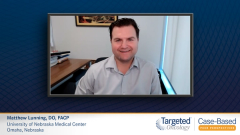
R/R DLBCL: Data from the RE-MIND2 Trial
Matthew Lunning, DO, FACP, shares data from the RE-MIND2 trial and explains how it compares to the L-MIND trial.
Episodes in this series

Case Overview: A 64-Year-Old Man with Diffuse Large B-Cell Lymphoma (DLBCL)
Case History
June 2020: A 64-year-old man presented with DLBCL
Stage III disease
ECOG PS 2
Serum LDH=3.7 x ULN
NCCN-IPI score=6 (High-risk)
History of hypertension (well-controlled)
Patient does not harbor MYC, BCL2, or BCL6 rearrangements
July 2020: Patient began treatment with RCHOP (rituximab, cyclophosphamide, doxorubicin, vincristine, prednisone) induction therapy
Patient had neutropenic fever and limiting fatigue that was controlled with growth factor support; also had mild neuropathy
Underwent interim CT scan after 3 cycles/9 weeks and again at completion of therapy (6 cycles/18 weeks)
Patient achieved a metabolic complete response at 18-week PET-CT scan
May 2021 (6 months post–RCHOP completion): the patient complained of recent weight loss, fatigue
Followup CT scan revealed that the patient had relapsed disease
Patient started salvage chemotherapy with R-GemOx (rituximab, gemcitabine, oxaliplatin)
Most Recent Follow-up Notes/Labs
November 2021: 6-month for-cause CT scan and subsequent biopsy revealed that the patient was refractory to GemOx
The patient lives 50 miles from a healthcare facility that administers CAR T-cell therapy and does not have reliable transportation or continuous caregiver support; he and his clinician decided to start 3rd-line tafasitamab/lenalidomide
April 2022: The patient remains on tafasitamab/lenalidomide; fatigue has mostly resolved
Matthew Lunning, DO, FACP: RE-MIND2 is an interesting twist on how we typically do some observational studies. Here you have them taking the L-MIND patient population and looking at their characteristics and outcomes, pulling from a very large data set of thousands of patients with relapsed/refractory diffuse large B-cell lymphoma and keying out important key characteristics of their disease and trying to do some matching into a retrospective cohort that then matched to the prospective cohort seen in the L-MIND data set. That was the RE-MIND2 data set.
There was a retrospective population being compared with the prospective population in the L-MIND data set. They took those patients who were in the retrospective data set who would have received drugs like pola–BR [polatuzumab vedotin, bendamustine, rituximab]. I believe there were other all-comer second-line salvage regimens, and then interestingly CAR [chimeric antigen receptor] T cell. What bore out over time is that some of the efficacy outcomes were equivalent to utilization of tafasitamab-lenalidomide to those populations, like CAR T cell or pola-BR [polatuzumab vedotin, bendamustine, rituximab]. It’s comparing retrospective to prospective data, but it can be thought generating or hypothesis generating between the 2 populations. In the end, because there’s unlikely to be a tafasitamab-lenalidomide vs a pola-BR [polatuzumab vedotin, bendamustine, rituximab] trial, this is the best data we’re going to get when you try to do age-matched patient populations, noting that the best comparator between the 2 would be a prospective randomized trial between the 2 regimens.
Walking through this patient’s case, there are lines and then you have to color the lines. That’s where you have to know what the frontline R-CHOP [rituximab, cyclophosphamide, doxorubicin, vincristine, prednisone] and the tolerance were. You have to understand the logistical factors that affect this patient’s life and their family’s lives. Some patients choose to travel hours, sometimes days, to get to a CAR T-cell center, and others won’t. The important thing is the discussion that led to the decision to not get therapy that was potentially amenable to going toward a transplant, or utilizing the data in the second-line CAR T cell of what led to not going toward CAR T cell in the second- or third-line setting.
In this case, there wasn’t the opportunity to travel, have good care support, or have good caregiver support before and after CAR T-cell therapy. That led to the decision to give tafasitamab-lenalidomide. Given that this individual fell within those criteria, given the data, tafasitamab would be a reasonable third-line treatment regimen. My only question is if you had the CAR T-cell question in the second line and you knew that you weren’t going to go toward CAR T-cell because of logistical concerns and whatnot and this patient had recurred within 6 months of R-CHOP [rituximab, cyclophosphamide, doxorubicin, vincristine, prednisone] chemotherapy. If I could have given them tafasitamab in the second line rather than in the third line and spared them what I felt has a very low chance of efficacy and durability with R-gem-ox [rituximab, gemcitabine, oxaliplatin], I would have rather given them tafasitamab-lenalidomide in the second line of therapy than wait until they had refractory disease in the second line.
Transcript edited for clarity.










































